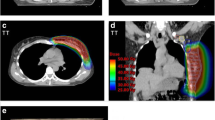Background:
Radiotherapy of internal mammary lymph nodes (IMN) in breast cancer is discussed controversially due to its potential toxicity and debatable efficacy. Aim of the present study was to assess the cardiac and lung dose in 3-D planned radiotherapy and to discuss these results with regard to arguments pro and contra IMN irradiation.
Patients and Methods: 32 patients underwent 3-D planning (Helax TMS) for irradiation of breast and IMN in three different techniques either using separate IMN fields (A, B) or a wide tangent (C). For each technique the respective doses to the heart (including the base of the aorta and the ostium of the coronary arteries) and lung were analyzed in dose volume histograms.
Results: The mean dose to the heart (left side irradiation) was 6.4 Gy (A), 8.1 Gy (B) and 3.8 Gy (C). The mean dose to the lung was 11.7 Gy (A), 15.4 Gy (B) and 10.2 Gy (C). The 10-Gy isodose comprised 19.5% (A), 32.9% (B) and 5.6% (C) of the heart (left breast). The respective values for the 20-Gy isodose were 7.8, 11.5 and 4.4%. The irradiated volumes of the lung were 37.7% (A), 52.7% (B) and 20% (C) in the 10-Gy isodose. The 20-Gy isodose comprised 16.7% (A), 28.3% (B) and 17.8% (C).
Conclusion: Whether radiotherapy of the IMN may improve treatment results in breast cancer is currently unresolved. However, the present data indicate that relevant cardiovascular side effects are unlikely to occur. Thus, the indication should be considered on the basis of individual risk factors.
Hintergrund:
Die Strahlentherapie der Mammaria-interna-Lymphknoten (IMN) wird kontrovers diskutiert, da ihre potenzielle Toxizität gefürchtet und ihre Wirksamkeit angezweifelt werden. Ziel der vorliegenden Studie war, die Herz- und Lungendosis bei 3-D-geplanter Strahlentherapie zu ermitteln und anhand dieser Resultate die Argumente für und wider eine IMN-Bestrahlung zu diskutieren.
Patienten und Methoden: Bei 32 Patientinnen erfolgte die 3-D-Planung (Helax TMS) zur Brust- und IMN-Bestrahlung in drei verschiedenen Techniken entweder mit separatem Retrosternalfeld (AB) oder als flache Tangente. Für jede Methode wurde die Dosisbelastung für Herz (einschließlich Aortenbasis und Ostien der Herzkranzgefäße) und Lunge in Dosis-Volumen-Histogrammen analysiert.
Resultate: Bei linksseitiger Bestrahlung betrug die mittlere Dosis am Herzen 6,4 Gy (A), 8,1 Gy (B) und 3,8 Gy (C) und an der Lunge 11,7 Gy (A), 15,4 Gy (B) und 10,2 Gy (C). Die 10-Gy-Isodose umfasste 19,5% (A), 32,9% (B) und 5,6% (C) des Herzens. Die entsprechenden Volumina in der 20-Gy-Isodose lagen bei 7,8, 11,5 und 4,4%. Das bestrahlte Volumen der ipsilateralen Lunge betrug 37,7% (A), 52,7% (B) und 20% (C) bei der 10-Gy-Isodose. Die 20-Gy-Isodosen umschloss 16,7% (A), 28,3% (B) und 17,8% (C).
Schlussfolgerung: Ob die Mitbestrahlung der IMN die Therapieergebnisse beim Mammakarzinom verbessert, ist derzeit ungeklärt. Die vorgestellten Daten deuten jedoch darauf hin, dass diese nicht mit einem relevanten Risiko für kardiovaskuläre Nebenwirkungen einhergeht. Die Indikation sollte deshalb anhand individueller Risikofaktoren gestellt werden.
Similar content being viewed by others
Author information
Authors and Affiliations
Additional information
Received: December 11, 2000; accepted: August 22, 2001
Rights and permissions
About this article
Cite this article
Sautter-Bihl, ML., Hültenschmidt, B., Melcher, U. et al. Radiotherapy of Internal Mammary Lymph Nodes in Breast Cancer Principle Considerations on the Basis of Dosimetric Data. Strahlenther Onkol 178, 18–24 (2002). https://doi.org/10.1007/s00066-002-0848-4
Issue Date:
DOI: https://doi.org/10.1007/s00066-002-0848-4




